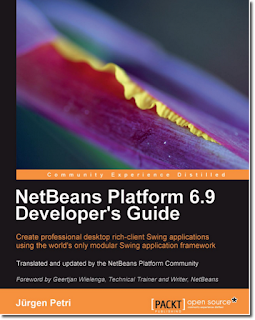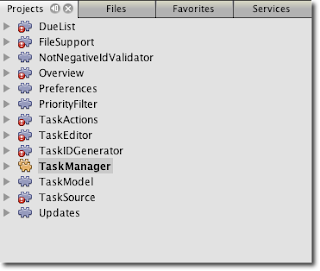This book
NetBeans Platform 6.9 Developer's Guide offers to help you in your transition from a Java Developer to become a NetBeans Platform Developer. The approach used in this book is an approach by example. Teaching through an example is a powerful pedagogical pattern which works. This book has assumed a requirement for creating a software with certain features and gradually progresses to develop this assumed software through many chapters. Through different chapters this book tries to teach a developer new concepts which are used in NetBeans Platform like Lookup, Window Systems, Nodes, File System and layer mechanism to name a few. I liked this approach of teaching through an example software requirement.
Developers are most comfortable when someone explains them through code examples. When a book offers learning by example it is always a pleasure. My first reaction was to search for any code sample if provided by the publishing company. I downloaded the code sample from Packt Publishing book page. When developers try to learn a new concept and write code according to instructions the sample code provide a check point to compare whether they have done it write.
The code sample provides significant data to compare but it would be more helpful with some additional things mentioned below:
- As of today the code sample does not compile on NetBeans IDE 6.9 out of the box, as it needs some changes in the settings
- The presentation locale for the code sample is in German and hence less intuitive to an English reader
- The changes in the settings like Lookup module, deprecated Swing extension module can be done by developers who already know some NetBeans platform concepts but for a total beginner they may render the code sample useless.
- The code sample is the final version of the software which gets developed progressively through the chapters so it does not help much in the initial chapters, if the code sample is available in chapter wise format it will be a great aid for the book.
The instructions given in the book if followed word by word and line by line, then they do not work in some places. This was a frustrating thing for me. I could figure out the changes needed as I am well ahead in the NetBeans Platform learning curve and have read 2 more books on NetBeans Platform and have watched the top 10 API videos by Geertjan.
For a total beginner the instructions given in the book MUST work when followed exactly word by word and line by line, to give a smooth experience and to avoid frustration. For me this doesn't happened with this book. Blindly following the instructions in the book do not lead to smooth running application and need some refactoring of access (like making certain packages public), one misplaced illustration as mentioned in the the errata on NetBeans wiki and other corrections also mentioned on the errata page.
I came to know about the
ERRATA for this book at Packt Publishing site and also one
ERRATA maintained by community at the NetBeans Wiki
here. This Errata is a MUST to follow to make the instructions in the book work for you. So using this book plus the errata on the NetBeans wiki makes the book complete in all the instructions. With this correction this book will help a Java developer kick start as a NetBeans Developer.
In summary the plus points of the book are:
- Teaching by example pedagogical approach
- Way of teaching and the language is easy to understand.
- Lots of illustrations
- Step by step instructions which can be followed to recreate what has been taught (Requires help from errata published on NetBeans wiki)
- Experience of creating a complete software using NetBeans Platform towards the end of the book
and the minus points, which I believe will be corrected gradually by Packt publishing by publishing complete errata on their site and fixing the text in next edition
- Code sample not chapter wise
- Code sample not in English locale
- Many corrections required in book to make it work in code as expected by the author. This point is disappointing for a total new developer as they may have no clue about how to correct these errors, and the errata maintained by community is a must reference in that case.
In conclusion Packt Publishing has added one more interesting book in the range of
NetBeans Platform learning books. This book gives the feel of NetBeans Platform development quickly and provides opportunity for developers to kick start their journey in the NetBeans Platform land.
With regards
Tushar Joshi, Nagpur
.









